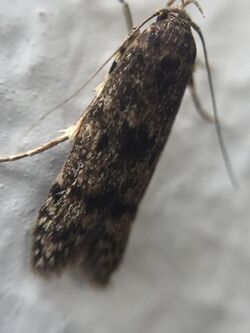Biology:Blastobasis marmorosella
| Blastobasis marmorosella | |
|---|---|

| |
| Scientific classification Error creating thumbnail: Unable to save thumbnail to destination
| |
| Domain: | Eukaryota |
| Kingdom: | Animalia |
| Phylum: | Arthropoda |
| Class: | Insecta |
| Order: | Lepidoptera |
| Family: | Blastobasidae |
| Genus: | Blastobasis |
| Species: | B. marmorosella
|
| Binomial name | |
| Blastobasis marmorosella (Wollaston, 1858)
| |
| Synonyms[1] | |
| |
Blastobasis marmorosella is a moth in the family Blastobasidae.[1] It is found on the Canary Islands, Madeira and in Portugal and Spain .[2] This species has been accidentally introduced to Australia and New Zealand.[3]
Taxonomy
This species was first described by Thomas Vernon Wollaston in 1858 and named Oecophora marmorosella.[4] In 1892 Hans Rebel placed this species within the genus Blastobasis.[5] In 2004 this species was reviewed.[1] The female lectotype, collected in Madeira, is held in the Natural History Museum, London.[1]
Description
This species was described in 2004 by Ole Karsholt and Sergey Yu Sinev as follows:
Wingspan 16-23 mm. Head and scape of antenna light brown mottled with dark brown; flagellum dark brown, indistinctly lighter ringed, with deep basal notch in male. Labial palpi long and slender; segment 2 yellowish mottled with brown; segment 3 as long as segment 2, brown mottled with blackish. Thorax and tegulae dark grey brown. Forewing relatively broad with somewhat pointed apex, light brown mottled with dark brown and fuscous, base and basal part of dorsum blackish brown; a blackish patch at dorsum at 1⁄3, continuing as a fascia to costa; a blackish spot between this and base and one such spot between the blackish fascia and a double black spot at 4⁄5; indistinct black spots along termen from subapical to tornal spots; fringes light brownish grey. Hindwing rather broad, apically somewhat rounded, grey with light brown-grey fringes.[1]
Distribution
This species is likely indigenous to Madeira and Porto Santo.[3] It was first recorded in New Zealand in 1988 and in the 19 years since that first record only 8 specimens have been collected.[3]
References
| Wikimedia Commons has media related to Blastobasis marmorosella. |
- ↑ 1.0 1.1 1.2 1.3 1.4 , pp. 418-420, Wikidata Q105897744
- ↑ "Fauna Europaea". https://fauna-eu.org/t/.
- ↑ 3.0 3.1 3.2 , Wikidata Q110305107
- ↑ , pp. 121, Wikidata Q99838337
- ↑ , pp. 276-278, Wikidata Q100979033
Wikidata ☰ Q9658790 entry
 |

